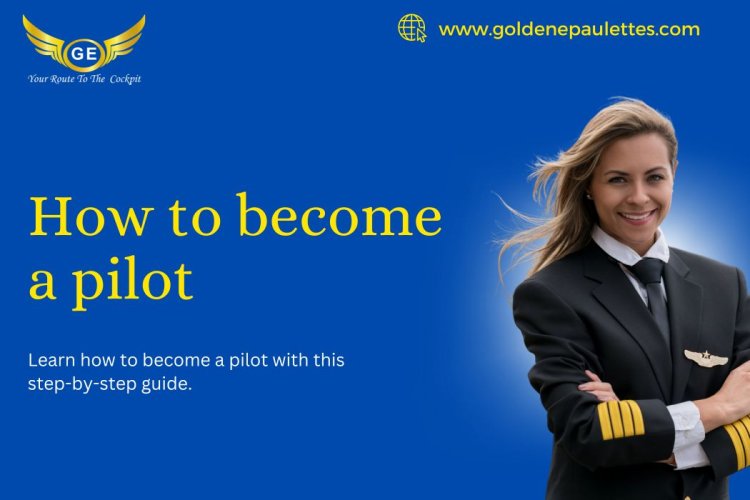Understand the essential steps to take if you want to become a pilot.
Becoming a pilot is a dream career for many aviation enthusiasts. The journey to becoming a pilot involves several steps, from obtaining the right education and training to earning various certifications.

How to Become a Pilot: Essential Steps and Costs in INR
Introduction
Becoming a pilot is a dream career for many aviation enthusiasts. The journey to becoming a pilot involves several steps, from obtaining the right education and training to earning various certifications. If you're wondering how to become pilot in India and what it costs, this comprehensive guide will walk you through everything you need to know.
Step 1: Meet Basic Eligibility Criteria
To pursue a career as a pilot, you must meet certain eligibility criteria:
- Age Requirement: Minimum age of 17 years for a Student Pilot License (SPL) and 18 years for a Commercial Pilot License (CPL).
- Educational Qualification: Completion of 10+2 with Physics, Mathematics, and English from a recognized board.
- Medical Fitness: Clear a Class II Medical Examination (for SPL) and a Class I Medical Examination (for CPL) approved by the Directorate General of Civil Aviation (DGCA).
Step 2: Choose Your Preferred Pilot License
There are different types of pilot licenses you can pursue based on your career goals:
- Student Pilot License (SPL): An entry-level license to begin your flight training.
- Private Pilot License (PPL): Allows you to fly privately but not for commercial purposes.
- Commercial Pilot License (CPL): Required to work as a professional pilot and earn a salary.
- Airline Transport Pilot License (ATPL): The highest certification, allowing you to become a captain for commercial airlines.
Step 3: Join a Reputed Flight School
Enrolling in a DGCA-approved flying school is crucial. In India, several aviation academies offer training programs, such as:
- Indira Gandhi Rashtriya Uran Akademi (IGRUA), Uttar Pradesh
- Bombay Flying Club, Mumbai
- Madhya Pradesh Flying Club, Indore
- Rajiv Gandhi Aviation Academy, Hyderabad
The training typically includes Ground Training and Flight Training:
- Ground Training: Focuses on aviation theory, regulations, meteorology, navigation, and communication.
- Flight Training: Hands-on flying lessons, including solo and cross-country flights.
Step 4: Obtain Required Flight Hours
To qualify for a Commercial Pilot License (CPL), you need to complete at least 200 flying hours. These hours are divided into:
- Dual Flying (with an instructor): Approximately 150 hours.
- Solo Flying: Around 50 hours.
- Cross-Country Flights: Including night flying and instrument flying.
Step 5: Pass the Written and Practical Exams
You must pass DGCA-conducted written exams on topics like Air Navigation, Aviation Meteorology, Air Regulations, and Technical General. Additionally, you need to clear:
- Flight Radio Telephony Operator’s License (FRTOL) Exam.
- Skill Test (Check Ride): Practical flying test to demonstrate your proficiency.
Step 6: Medical Certification
Passing a Class I Medical Examination is essential for obtaining a Commercial Pilot License. The medical exam includes tests for vision, hearing, cardiovascular health, neurological health, and overall physical fitness.
Step 7: Cost of Becoming a Pilot (In INR)
Training to become a pilot in India can be expensive.how to become pilot Here’s a breakdown of the estimated costs:
- SPL (Student Pilot License): ₹1 - 2 lakh.
- PPL (Private Pilot License): ₹8 - 10 lakh.
- CPL (Commercial Pilot License): ₹25 - 35 lakh.
- ATPL (Airline Transport Pilot License): Additional ₹10 - 15 lakh.
Total Estimated Cost: ₹35 - 50 lakh, depending on the flight school and training type.
Step 8: Career Opportunities After Becoming a Pilot
Once you have your Commercial Pilot License, you can explore various career paths:
- Commercial Airline Pilot: Working with airlines like Air India, IndiGo, SpiceJet, etc.
- Cargo Pilot: Flying cargo aircraft for logistics companies.
- Charter Pilot: Operating private jets and chartered flights.
- Flight Instructor: Teaching aspiring pilots and building more flight hours.
- Corporate Pilot: Flying private aircraft for business executives.
Challenges of Becoming a Pilot
While the profession is exciting, it has its challenges:
- High Training Costs: The financial investment required is substantial.
- Intense Training: Learning to fly involves rigorous training and assessments.
- Medical Standards: Regular medical check-ups are required to maintain your license.
- Competition: The aviation industry is highly competitive, especially for airline jobs.
Rewards of Becoming a Pilot
Despite the challenges, a career in aviation offers numerous rewards:
- Lucrative Salary Packages: Commercial pilots earn attractive salaries.
- Travel Opportunities: The chance to explore various destinations.
- Prestige and Respect: Being a pilot is considered a prestigious profession.
- Job Satisfaction: A fulfilling career for those passionate about flying.
Conclusion
Understanding how to become pilot in India requires careful planning, dedication, and significant financial investment. However, the rewards are well worth the effort. From the thrill of flying to the handsome pay packages, a pilot’s career offers excitement and satisfaction. Whether you aim to fly commercial airliners or work as a private pilot, following the steps mentioned above will set you on the right path toward a successful aviation career.
What's Your Reaction?


















.jpg)